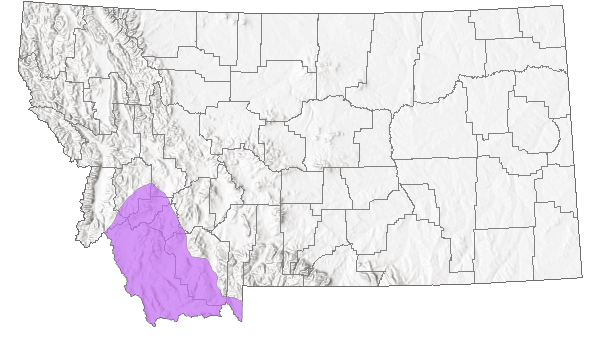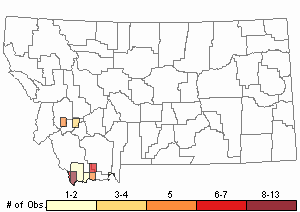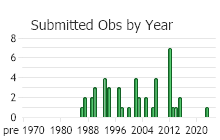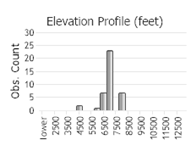View in other NatureServe Network Field Guides
NatureServe
Montana
Utah
Wyoming
Idaho
Wisconsin
British Columbia
South Carolina
Yukon
California
New York
Alpine Meadowrue - Thalictrum alpinum
State Rank Reason (see State Rank above)
Rare in Montana, where it is known from approximately two dozen sites mostly on public land. Its habitat is vulnerable to hydrological alteration. Grazing can be beneficial, except where it leads to stream downcutting and loss of riparian habitat.
- Details on Status Ranking and Review
Population Size
Score1 - Moderate: Generally 10,000-100,000 individuals.
Range Extent
Score1 - Peripheral, Disjunct or Sporadic Distribution in MT: Widespread species that is peripheral, disjunct or sporadically distributed within MT such that it occurs in <5% of the state (<7,500 sq. miles or the combined area of Beaverhead and Ravalli Counties) or is restricted to 4-5 sub-basins.
Area of Occupancy
Score2 - Low: Generally occurring in 4-10 Subwatersheds (6th Code HUC’s).
Environmental Specificity
Score2 - High: Species is restricted to a highly specialized and limited habitat and is typically dependent upon unaltered, high-quality habitat (C Values of 8-10).
Trends
Score1 - Minor Declines: Species has experienced declines of 10-30% in population size, range extent and/or occupied area in the recent past (approximately 30 years).
CommentTrend data are unavailable. Estimated based upon potential alteration/degradation of some of the species' habitat.
Threats
Score1-2 - Medium to High.
Intrinsic Vulnerability
Score1 - Moderate Vulnerability: Specific biological attributes, unusual life history characteristics or limited reproductive potential makes the species susceptible to extirpation from stochastic events or other adverse impacts to its habitat and slow to recover.
Raw Conservation Status Score
Score
9 to 10 total points scored out of a possible 19.
General Description
Monoecious. Stems glaucous 10–20 cm with glabrous, glaucous foliage. Leaves mainly basal, twice ternate to bipinnate, ultimate leaflets leathery, 2–7 mm long, 3- to 5-lobed. Inflorescence racemose with 8 to 15 nodding flowers. Flowers perfect; sepals purplish, 1–2 mm; anthers ca. 2 mm long, longer than the filaments. Fruits 2 to 6 spreading achenes, the body 2–3 mm long, on nodding pedicels (
Lesica et al. 2012. Manual of Montana Vascular Plants. BRIT Press. Fort Worth, TX).
Phenology
Flowering occurs in late May and June, and fruiting in July.
Diagnostic Characteristics
Alpine meadowrue is less than 20 cm tall with thin stems and all leaves near the base (and consequently is very inconspicuous among the taller, denser graminoids with which it grows). Other species of Thalictrum are taller and have leaves along the stem.
Species Range
Montana Range
Range Descriptions

 Native
Native
Range Comments
Circumpolar. AK to Greenland south at scattered locales to CA, NM, CO; Eurasia (Lesica et al. 2012. Manual of Montana Vascular Plants. BRIT Press. Fort Worth, TX).
Observations in Montana Natural Heritage Program Database
Number of Observations: 46
(Click on the following maps and charts to see full sized version)
Map Help and Descriptions
Relative Density

Recency



 (Observations spanning multiple months or years are excluded from time charts)
(Observations spanning multiple months or years are excluded from time charts)
Habitat
Alpine meadowrue typically grows in moist montane and lower subalpine areas. In southwestern Montana, it occurs in moist alkaline meadows dominated by Potentilla fruticosa (shrubby cinquefoil) and Juncus balticus (Baltic rush), sometimes along stream channels. Frequent associates include Deschampsia cespitosa, Dodecatheon pulchellum, Salix brachycarpa, Arctostaphylos uva-ursi, and Muhlenbergia richardsonis. The substrate varies from peat to marl, calcareous silt, silty clay or clay loam, often on limestone parent material.
National Vegetation Classification System Groups Associated with this Species
Wetland and Riparian
Alpine Riparian and Wetland
Peatland
Riparian Shrubland
Wet Meadow and Marsh
Ecology
Alpine meadowrue often occurs on the upper portions of hummocks, suggesting that it may favor a more open, somewhat drier microhabitat.
Management
Livestock grazing creates hummocky habitat and may benefit alpine meadowrue. Grazing may also reduce the vigor of taller graminoids that shade this diminutive species. However heavy grazing and trampling can reduce species diversity, potentially impacting this plant and increasing the chance of exotic invasion (Lesica, 1990). Alpine meadowrue is also vulnerable to hydrologic alteration of its wetland habitat. Stream diversion could lower water tables, and heavy grazing could destabilize banks, causing channel downcutting that leads to lower water tables.
Stewardship Responsibility
Threats or Limiting Factors
STATE THREAT SCORE REASON
Reported threats to Montana's populations of Alpine Meadowrue include actions that either prevent disturbance or result in extreme disturbance to its habitat or manipulate hydrology (MTNHP Threat Assessment 2021). Plants grow on the tops and sides of hummocks within wet meadows or wetlands. Severe livestock trampling may inflict negative impacts when soil compaction and related water table decline renders conditions that cannot be tolerated by Alpine Meadowrue plants. However, moderate livestock trampling is necessary to maintain hummocked substrates, and potentially reduces the stress of competition with other species. Observations from a treatment using a livestock exclosure found relatively higher water level and lower plant abundance where livestock use was absent.
References
- Literature Cited AboveLegend:
 View Online Publication
View Online Publication Lesica, P., M.T. Lavin, and P.F. Stickney. 2012. Manual of Montana Vascular Plants. Fort Worth, TX: BRIT Press. viii + 771 p.
Lesica, P., M.T. Lavin, and P.F. Stickney. 2012. Manual of Montana Vascular Plants. Fort Worth, TX: BRIT Press. viii + 771 p. MTNHP Threat Assessment. 2021. State Threat Score Assignment and Assessment of Reported Threats from 2006 to 2021 for State-listed Vascular Plants. Botany Program, Montana Natural Heritage Program, Helena, Montana.
MTNHP Threat Assessment. 2021. State Threat Score Assignment and Assessment of Reported Threats from 2006 to 2021 for State-listed Vascular Plants. Botany Program, Montana Natural Heritage Program, Helena, Montana.
- Additional ReferencesLegend:
 View Online Publication
View Online Publication
Do you know of a citation we're missing? Clark, D. 1991. The effect of fire on Yellowstone ecosystem seed banks. M.Sc. Thesis. Montana State University, Bozeman. 115 pp.
Clark, D. 1991. The effect of fire on Yellowstone ecosystem seed banks. M.Sc. Thesis. Montana State University, Bozeman. 115 pp. Culver, D.R. 1994. Floristic analysis of the Centennial Region, Montana. M.Sc. Thesis. Montana State University, Bozeman. 199 pp.
Culver, D.R. 1994. Floristic analysis of the Centennial Region, Montana. M.Sc. Thesis. Montana State University, Bozeman. 199 pp. Fertig, W. and G. Jones. 1992. Plant communities and rare plant species of the Swamp Lake Botanical Area, Clark's Fork Ranger District, Shoshone National Forest. Unpublished report to the Shoshone National Forest. Challenge Cost Share Agreement No. CSA-2-91-14-0001. Wyoming Natural Diversity Database. 113+ pp.
Fertig, W. and G. Jones. 1992. Plant communities and rare plant species of the Swamp Lake Botanical Area, Clark's Fork Ranger District, Shoshone National Forest. Unpublished report to the Shoshone National Forest. Challenge Cost Share Agreement No. CSA-2-91-14-0001. Wyoming Natural Diversity Database. 113+ pp. Jones, W. W. 1901. Preliminary flora of Gallatin County. M.S. Thesis. Bozeman, MT: Montana State College. 78 pp.
Jones, W. W. 1901. Preliminary flora of Gallatin County. M.S. Thesis. Bozeman, MT: Montana State College. 78 pp. King, C. R. 1953. The Ranunculaceae of Montana. M.S. Thesis, Bozeman, MT: Montana State College. 82 p.
King, C. R. 1953. The Ranunculaceae of Montana. M.S. Thesis, Bozeman, MT: Montana State College. 82 p. Lesica, P. 1990. Vegetation and sensitive vascular plants of Morrison Lake, Harkness Lakes and Nicholia Creek wetlands, Beaverhead County, Montana. Report to Beaverhead National Forest, Dillon, Montana. 28 pp.
Lesica, P. 1990. Vegetation and sensitive vascular plants of Morrison Lake, Harkness Lakes and Nicholia Creek wetlands, Beaverhead County, Montana. Report to Beaverhead National Forest, Dillon, Montana. 28 pp. Lesica, P., M.T. Lavin, and P.F. Stickney. 2022. Manual of Montana Vascular Plants, Second Edition. Fort Worth, TX: BRIT Press. viii + 779 p.
Lesica, P., M.T. Lavin, and P.F. Stickney. 2022. Manual of Montana Vascular Plants, Second Edition. Fort Worth, TX: BRIT Press. viii + 779 p. Vanderhorst, J.P. and P. Lesica. 1995a. Sensitive plant survey of the Tendoy Mountains in the Beaverhead National Forest, Beaverhead County, Montana. Unpublished report to the Bureau of Land Management, Butte District. Montana Natural Heritage Program, Helena, MT. 59 pp. plus appendices.
Vanderhorst, J.P. and P. Lesica. 1995a. Sensitive plant survey of the Tendoy Mountains in the Beaverhead National Forest, Beaverhead County, Montana. Unpublished report to the Bureau of Land Management, Butte District. Montana Natural Heritage Program, Helena, MT. 59 pp. plus appendices.
- Web Search Engines for Articles on "Alpine Meadowrue"





